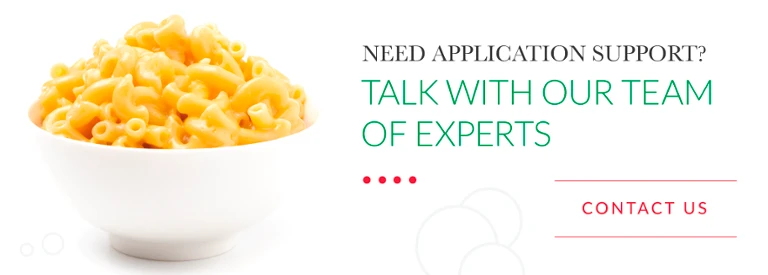
In January 2025, the U.S. Food and Drug Administration (FDA) proposed a rule that would mandate front-of-package nutrition labels for most packaged foods, and they’re requesting feedback by May 16, 2025, to determine next steps.
These proposed changes aim to provide consumers with at-a-glance information on key nutrients, including saturated fat, sodium and added sugars. It’s speculated that the current administration will finalize this legislation.
In this article, we’ll take a closer look at sodium reduction, in particular, as it often poses greater challenges for formulators, and include tips that can help formulators prepare for the potential changes.
The Challenge of Reduced Sodium
Formulators have made significant strides in reducing fat, calories and sugar in foods. Many food and beverage companies already promote these types of claims on front packaging, and consumers have generally embraced them.
Sodium has been a different story, however. Not only do low-sodium foods generally face the stigma of bland flavors, but they also can be more difficult to formulate.
When reducing fat and calories, for example, sodium is frequently added to make them more palatable. Salt enhances taste and can mask off-notes from other ingredients or from functional substitutes like starches or artificial sweeteners.
Finding success and consumer appeal with low-sodium formulations has been a challenge. Here, we’ll take a look at where things stand, what the labeling rules might mean and potential strategies for complying with sodium-reduction initiatives without compromising consumer appeal.
RELATED: Better-for-You Cheese Sauce Trends
The Facts About Sodium Consumption
What are consumers eating these days? Despite the health risks, many in the U.S. continue to consume too much sodium. They certainly love their salty snacks and entrees:
- Americans consume an average of about 3,400 milligrams (mg) of sodium per day
- The FDA and medical professionals recommend that adults limit their sodium intake to less than 2,300 mg per day, which is approximately one teaspoon of table salt
- Over 70% of the sodium consumed comes from packaged and prepared foods, with significant contributions from items such as deli meat, pizza, soups, snacks, pasta dishes, cheese sauces and other savory dishes
- More than 90% of people in the U.S. exceed the recommended sodium limits across almost all age groups
- Excessive sodium intake is linked to increased blood pressure and a higher risk of heart disease and stroke, according to the CDC
These statistics underscore the importance of monitoring and reducing sodium intake to promote better health outcomes.
Overview of the Proposed Nutrition Info Box
What might the design and placement of the proposed "Nutrition Info Box" look like? The rule states that it should be prominently placed in the top third of the food package's principal display panel. It would need to categorize the levels of saturated fat, sodium and added sugars as "Low," "Med," or "High," corresponding to specific percentages of the Daily Value (%DV):
- Low: 5% DV or less
- Med: 6% to 19% DV
- High: 20% DV or more
Compliance Timeline. If finalized, food manufacturers with annual sales of $10 million or more would have three years to comply, while smaller businesses would have four years.
Flavor & Function: The Role of Sodium in Cheese Sauce Formulations
The FDA’s initiative not only aims to help consumers make more informed dietary choices, but it will also encourage the food and beverage industry to formulate healthier products. Some of the more difficult-to-formulate reduced-sodium applications are cheese sauces used in nacho dips, spreads and pasta sauces like macaroni and cheese.
Cheese sauces rely heavily on salt to enhance the natural umami of cheese, balance richness from fats and suppress bitterness. When sodium is reduced, the sauce can taste bland, and consumers are quick to notice the drop in flavor.
Salt doesn’t just act as a seasoning in cheesy applications; it directly affects the behavior of cheese and dairy proteins by helping to prevent viscosity breakdown, influencing texture and mouthfeel. Cheese sauces often become watery, grainy or prone to syneresis without enough sodium, a major issue for ready-to-eat applications. And, when held on a hot-hold steam table for prolonged periods, cheese entrees can become gummy or tacky.
RELATED: Sodium Alternative Formulation Challenges
Tips for Sodium Reduction Compliance in Cheese Sauces
Grande Custom Ingredients Group is dedicated to supporting food manufacturers in creating healthier products without compromising on taste or quality. Our proprietary cheese replacement ingredient, Grande Gusto®, can help formulators reduce sodium, fat and calories, providing the following benefits:
Functionality. Grande Gusto serves as a partial replacement — up to 50% — for cheese, processed cheese and cheese powder in formulations. It enhances indulgent textures, is freeze-thaw stable and withstands thermal treatments.
Health Benefits. By incorporating Grande Gusto, manufacturers can reduce sodium in cheese sauces, soups and fillings by up to 10%, and fat and calories by up to 25%.
Flavor Enhancement. Despite the reduction in sodium, Grande Gusto enhances cheesy flavors due to its high mineral content and proprietary enzymes, actually increasing the salty flavor without adding sodium.
Clean Label. Aligning with clean label trends, Grande Gusto is a natural whey ingredient that supports the development of products with simplified and recognizable ingredient lists.
Request a Sample
As the FDA moves toward implementing front-of-package nutrition labeling, it’s critical for food manufacturers to proactively adapt to meet these new standards. The food scientists at Grande Custom Ingredients Group stand ready to collaborate with you to help formulate better-for-you cheese sauces. Contact our team today. 


